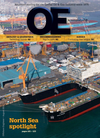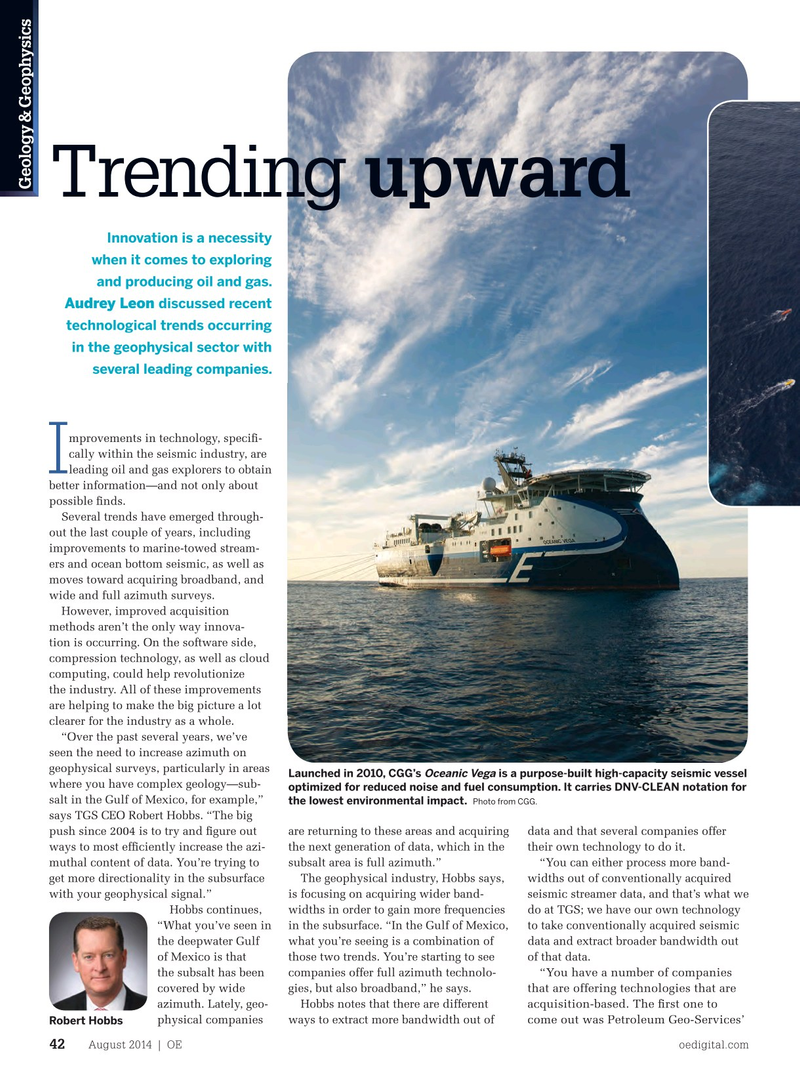
Page 40: of Offshore Engineer Magazine (Aug/Sep 2014)
Read this page in Pdf, Flash or Html5 edition of Aug/Sep 2014 Offshore Engineer Magazine
Geology & Geophysics
Trending upward
Innovation is a necessity when it comes to exploring and producing oil and gas.
Audrey Leon discussed recent technological trends occurring in the geophysical sector with several leading companies.
mprovements in technology, speci? - cally within the seismic industry, are
I leading oil and gas explorers to obtain better information—and not only about possible ? nds.
Several trends have emerged through- out the last couple of years, including (PGS) Geostreamer. Next, CGG came improvements to marine-towed stream- out with BroadSeis. Then WesternGeco ers and ocean bottom seismic, as well as came out with ObliQ and IsoMetrix. moves toward acquiring broadband, and
Each one of those technologies is an wide and full azimuth surveys. acquisition technique to acquire more
However, improved acquisition bandwidth in the subsurface. And TGS methods aren’t the only way innova- has used many of those technologies as tion is occurring. On the software side, well.” compression technology, as well as cloud
Craig Beasley, Chief Geophysicist computing, could help revolutionize and Schlumberger Fellow at the industry. All of these improvements
WesternGeco comments on the differ- are helping to make the big picture a lot ence between IsoMetrix technology clearer for the industry as a whole.
and other broadband techniques say- “Over the past several years, we’ve ing, “IsoMetrix offers broadband data seen the need to increase azimuth on ? nely sampled in all directions–verti- geophysical surveys, particularly in areas
Launched in 2010, CGG’s is a purpose-built high-capacity seismic vessel Oceanic Vega cally, inline to shooting, and crossline where you have complex geology—sub- optimized for reduced noise and fuel consumption. It carries DNV-CLEAN notation for between the towed streamers. This is salt in the Gulf of Mexico, for example,” the lowest environmental impact. Photo from CGG.
designed to improve the resolution says TGS CEO Robert Hobbs. “The big of complex geological details as well push since 2004 is to try and ? gure out are returning to these areas and acquiring data and that several companies offer as offering ? exibility for acquisition ways to most ef? ciently increase the azi- the next generation of data, which in the their own technology to do it.
ef? ciency.” muthal content of data. You’re trying to subsalt area is full azimuth.” “You can either process more band- widths out of conventionally acquired The geophysical industry, Hobbs says, get more directionality in the subsurface The Gulf of Mexico, Hobbs says is the seismic streamer data, and that’s what we is focusing on acquiring wider band- with your geophysical signal.” best laboratory for testing and deploying do at TGS; we have our own technology widths in order to gain more frequencies Hobbs continues, geophysical technology for a number of to take conventionally acquired seismic in the subsurface. “In the Gulf of Mexico, “What you’ve seen in important reasons.
data and extract broader bandwidth out what you’re seeing is a combination of the deepwater Gulf “It’s a very proli? c basin. A lot of com- of that data. those two trends. You’re starting to see of Mexico is that panies are exploring there, and therefore, “You have a number of companies companies offer full azimuth technolo- the subsalt has been they are willing to pay for the data,” he that are offering technologies that are gies, but also broadband,” he says. covered by wide says. “You also have a very good multi- acquisition-based. The ? rst one to
Hobbs notes that there are different azimuth. Lately, geo- client environment, which encourages come out was Petroleum Geo-Services’ ways to extract more bandwidth out of physical companies the geophysical companies to invest in
Robert Hobbs
August 2014 | OE oedigital.com 42 042_OE0814_G&G1.indd 42 7/22/14 5:35 PM

 39
39

 41
41